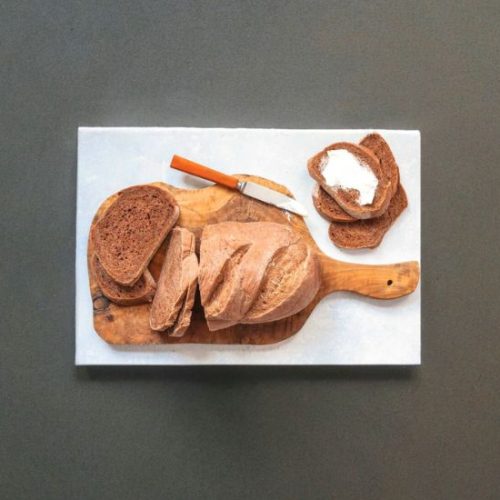
Rye Bread
This Homemade Rye Bread recipe yields two flavorful loaves with a perfect balance of hearty rye and soft bread flour. Sweetened gently with molasses and optionally spiced with caraway seeds, it offers a nutritious, delicious bread ideal for sandwiches or as a side dish. The dough requires two rises and a moderate kneading, resulting in a satisfying texture with a crisp crust and tender crumb.
Equipment
- 1 large mixing bowl
- 1 digital kitchen scale (optional but recommended)
- 2 bread loaf pans (8x4 inches) or baking stone
- 1 sharp serrated knife
- Measuring cups and spoons
Ingredients
- 2 packets active dry yeast 4 1/2 teaspoons or 16 grams
- 2 ½ cups warm water just warmed to touch
- ⅔ cup molasses regular, avoid blackstrap variety
- 2 tablespoons caraway seeds optional
- 1 tablespoon salt
- ¼ cup vegetable oil
- ¼ cup unsweetened cocoa powder
- 2 cups rye flour
- 5 cups bread flour approximately, adjust as needed
Instructions
- Activate the Yeast: In a large mixing bowl, combine the warm water and molasses, stirring gently to dissolve the molasses completely. Sprinkle the active dry yeast over the surface and let it sit for about 5–10 minutes until it becomes foamy, indicating the yeast is active and ready.
- Build the Dough: Add the salt, vegetable oil, cocoa powder, and caraway seeds (if using) to the yeast mixture. Stir well to incorporate. Gradually mix in the rye flour and then 2 cups of bread flour, stirring after each addition with a wooden spoon or sturdy spatula. Continue adding the remaining bread flour one cup at a time until the dough thickens enough that stirring becomes difficult.
- Knead the Dough: Lightly flour a clean surface and transfer the dough onto it. Begin kneading by pressing the heel of your hand into the dough, then stretching and folding it over. Turn the dough a quarter turn and repeat this pressing and folding motion. Continue kneading for 5 to 7 minutes, adding small amounts of flour as needed, until the dough feels smooth, elastic, and slightly tacky but no longer sticky.
- First Proofing: Coat a large bowl with a thin layer of vegetable oil. Place the kneaded dough into the bowl, turning it gently so all sides are lightly oiled. Cover the bowl tightly with plastic wrap or a damp kitchen towel. Let the dough rise at room temperature until it doubles in size, approximately 1 to 1.5 hours.
- Shape the Loaves: Once risen, gently deflate the dough by pressing it down. Turn it out onto a floured surface and knead it briefly to redistribute the air. Cut the dough evenly in half using a sharp knife. Shape each portion into a smooth loaf by folding and tucking the edges under, then place each loaf into a greased 8x4-inch bread pan or onto a baking sheet dusted with cornmeal for a crustier bottom.
- Second Proofing: Cover the loaves again with a clean cloth or plastic wrap and allow them to rise for 30 to 45 minutes. The dough should increase by about half its volume and just peek over the edges of the loaf pans if used.
- Prepare Oven and Bake: Preheat your oven to 350°F (175°C). If using a baking stone, place it in the oven at this time to heat thoroughly (at least 30 minutes). If baking on a stone, score the top of each loaf with a sharp serrated knife to allow for expansion. Optionally, mist the loaves with water in the first 10 minutes to encourage a crusty exterior. Bake for 40 to 50 minutes, until the crust is firm and the loaf sounds hollow when tapped.
- Cool and Enjoy: Remove the bread from the oven and let it cool in the pans or on the baking sheet for at least 15 minutes. Then transfer the loaves to a wire rack to cool completely before slicing.
Notes
- Molasses Choice: Use regular molasses rather than blackstrap for a milder sweetness and less bitterness. This helps balance the rye’s earthiness.
- Caraway Seeds: These are traditional in rye bread but optional; you can omit or replace with other seeds like fennel or cumin for variation.
- Flour Adjustment: The exact amount of bread flour may vary depending on humidity and flour brand; add flour gradually until the dough feels right—not sticky but still soft.
- Kneading Tip: Proper kneading develops gluten, creating that classic chewy rye bread texture. Don’t rush this step!
- Storage: Store cooled bread wrapped in a clean cloth or bread box for up to 3 days. For longer storage, slice and freeze to maintain freshness.